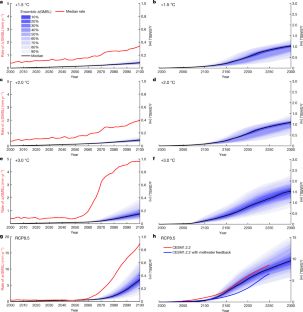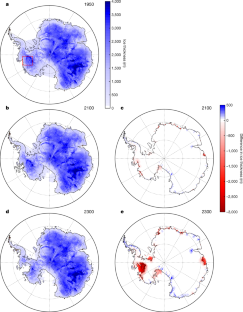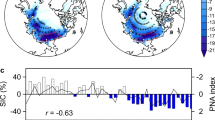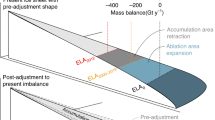The Paris Climate Agreement and future sea-level rise from Antarctica
The Paris Agreement aims to limit global mean warming in the twenty-first century to less than 2 degrees Celsius above preindustrial levels, and to promote further efforts to limit warming to 1.5 degrees Celsius 1 . The amount of greenhouse gas emissions in coming decades will be consequential for global mean sea level (GMSL) on century and longer timescales through a combination of ocean thermal expansion and loss of land ice 2 . The Antarctic Ice Sheet (AIS) is Earth’s largest land ice reservoir (equivalent to 57.9 metres of GMSL) 3 , and its ice loss is accelerating 4 . Extensive regions of the AIS are grounded below sea level and susceptible to dynamical instabilities 5,6,7,8 that are capable of producing very rapid retreat 8 . Yet the potential for the implementation of the Paris Agreement temperature targets to slow or stop the onset of these instabilities has not been directly tested with physics-based models. Here we use an observationally calibrated ice sheet–shelf model to show that with global warming limited to 2 degrees Celsius or less, Antarctic ice loss will continue at a pace similar to today’s throughout the twenty-first century. However, scenarios more consistent with current policies (allowing 3 degrees Celsius of warming) give an abrupt jump in the pace of Antarctic ice loss after around 2060, contributing about 0.5 centimetres GMSL rise per year by 2100—an order of magnitude faster than today 4 . More fossil-fuel-intensive scenarios 9 result in even greater acceleration. Ice-sheet retreat initiated by the thinning and loss of buttressing ice shelves continues for centuries, regardless of bedrock and sea-level feedback mechanisms 10,11,12 or geoengineered carbon dioxide reduction. These results demonstrate the possibility that rapid and unstoppable sea-level rise from Antarctica will be triggered if Paris Agreement targets are exceeded.
This is a preview of subscription content, access via your institution
Access options
Access Nature and 54 other Nature Portfolio journals
Get Nature+, our best-value online-access subscription
cancel any time
Subscribe to this journal
Receive 51 print issues and online access
196,21 € per year
only 3,85 € per issue
Buy this article
- Purchase on SpringerLink
- Instant access to full article PDF
Prices may be subject to local taxes which are calculated during checkout



Similar content being viewed by others

Acceleration of western Arctic sea ice loss linked to the Pacific North American pattern
Article Open access 09 March 2021

Glacial isostatic adjustment reduces past and future Arctic subsea permafrost
Article Open access 15 April 2024

Greenland ice sheet climate disequilibrium and committed sea-level rise
Article Open access 29 August 2022
Data availability
Model-generated data associated with this work are available with this paper. Three-dimensional ice-sheet model output associated with Fig. 2 and Extended Data Figs. 3, 5 are available at the ScholarWorks@UMASS Amherst repository (https://doi.org/10.7275/j005-r778). Climate model forcing used in our main ensembles and meltwater-feedback simulations (Fig. 1) are reported in refs. 46,80 . Source data are provided with this paper.
Code availability
The modified ice-sheet model codes based on ref. 51 are available from the corresponding author. CESM1.2.2 GCM 87 is available from NCAR (https://www.cesm.ucar.edu/models/cesm1.2/) and the RCM is reported in ref. 79 . The Earth–sea level model is described in refs. 12,49 .
References
- UNFCCC. Adoption of the Paris Agreement FCCC/CP/2015/L.9/Rev.1 (United Nations Framework Convention on Climate Change, 2015); https://unfccc.int/resource/docs/2015/cop21/eng/l09r01.pdf.
- Mengel, M., Nauels, A., Rogelj, J. & Schleussner, C.-F. Committed sea-level rise under the Paris Agreement and the legacy of delayed mitigation action. Nat. Commun. 9, 601 (2018). ArticlePubMedPubMed CentralADSCASGoogle Scholar
- Morlighem, M. et al. Deep glacial troughs and stabilizing ridges unveiled beneath the margins of the Antarctic ice sheet. Nat. Geosci. 13, 132–137 (2020). ArticleCASADSGoogle Scholar
- Shepherd, A. et al. Mass balance of the Antarctic Ice Sheet from 1992 to 2017. Nature558, 219–222 (2018). ArticleADSCASGoogle Scholar
- Weertman, J. Stability of the junction of an ice sheet and an ice shelf. J. Glaciol. 13, 3–11 (1974). ArticleADSGoogle Scholar
- Schoof, C. Ice sheet grounding line dynamics: steady states, stability, and hysteresis. J. Geophys. Res. Earth Surf. 112, F03S28 (2007). ArticleADSGoogle Scholar
- Pollard, D., DeConto, R. M. & Alley, R. B. Potential Antarctic Ice Sheet retreat driven by hydrofracturing and ice cliff failure. Earth Planet. Sci. Lett. 412, 112–121 (2015). ArticleCASADSGoogle Scholar
- DeConto, R. M. & Pollard, D. Contribution of Antarctica to past and future sea-level rise. Nature531, 591–597 (2016). ArticleCASPubMedADSGoogle Scholar
- Meinshausen, N. et al. The RCP greenhouse gas concentrations and their extensions from 1765 to 2300. Clim. Change109, 213–241 (2011). ArticleCASADSGoogle Scholar
- Barletta, V. R. et al. Observed rapid bedrock uplift in Amundsen Sea Embayment promotes ice-sheet stability. Science360, 1335–1339 (2018). ArticleCASPubMedADSGoogle Scholar
- Larour, E. et al. Slowdown in Antarctic mass loss from solid Earth and sea-level feedbacks. Science364, eaav7908 (2019). ArticleCASPubMedADSGoogle Scholar
- Gomez, N., Pollard, D. & Holland, D. Sea level feedback lowers projections of future Antarctic Ice Sheet mass loss. Nat. Commun. 6, 8798 (2015). ArticleCASPubMedPubMed CentralADSGoogle Scholar
- Fürst, J. J. et al. The safety band of Antarctic ice shelves. Nat. Clim. Chang. 6, 479 (2016). ArticleADSGoogle Scholar
- Paolo, F. S., Fricker, H. & Padman, L. Volume loss from Antarctic ice shelves is accelerating. Science348, 327–331 (2015). ArticleCASPubMedADSGoogle Scholar
- Gudmundsson, G. H. Ice-shelf buttressing and the stability of marine ice sheets. Cryosphere7, 647–655 (2013). ArticleADSGoogle Scholar
- Bassis, J. N. & Walker, C. C. Upper and lower limits on the stability of calving glaciers from the yield strength envelope of ice. Proc. R. Soc. Lond. A468, 913–931 (2012). ADSGoogle Scholar
- Parizek, B. R. et al. Ice-cliff failure via retrogressive slumping. Geology47, 1–4 (2019). ArticleGoogle Scholar
- Clerc, F., Minchew, B. M. & Behn, M. D. Marine ice cliff instability mitigated by slow removal of ice shelves. Geophys. Res. Lett. 46, 12108–12116 (2019). ArticleADSGoogle Scholar
- Vaughan, D. G. Relating the occurrence of crevasses to surface strain rates. J. Glaciol. 39, 255–266 (1993). ArticleADSGoogle Scholar
- Schlemm, T. & Levermann, A. A simple stress-based cliff-calving law. Cryosphere13, 2475–2488 (2019). ArticleADSGoogle Scholar
- An, L. et al. Bed elevation of Jakobshavn Isbræ, West Greenland, from high-resolution airborne gravity and other data. Geophys. Res. Lett. 44, 3728–3736 (2017). ArticleADSGoogle Scholar
- Khazendar, A. et al. Interruption of two decades of Jakobshavn Isbræ acceleration and thinning as regional ocean cools. Nat. Geosci. 12, 277–283 (2019). ArticleCASADSGoogle Scholar
- Joughin, I. et al. Seasonal to decadal scale variations in the surface velocity of Jakobshavn Isbræ, Greenland: observation and model-based analysis. J. Geophys. Res. Earth Surf. 117, F02030 (2012). ArticleADSGoogle Scholar
- Rignot, E. et al. Accelerated ice discharge from the Antarctic Peninsula following the collapse of Larsen B ice shelf. Geophys. Res. Lett. 31, L18401 (2004). ArticleADSCASGoogle Scholar
- Scambos, T. A., Berthier, E. & Shuman, C. A. The triggering of subglacial lake drainage during rapid glacier drawdown: Crane Glacier, Antarctic Peninsula. Ann. Glaciol. 52, 74–82 (2011). ArticleADSGoogle Scholar
- Milillo, P. et al. Heterogeneous retreat and ice melt of Thwaites Glacier, West Antarctica. Sci. Adv. 5, eaau3433 (2019). ArticleCASPubMedPubMed CentralADSGoogle Scholar
- Atkinson, B. K. Subcritical crack growth in geological materials. J. Geophys. Res. Solid Earth89, 4077–4114 (1984). ArticleCASGoogle Scholar
- Kuipers Munneke, P., Ligtenberg, S. R. M., van den Broeke, M. R. & Vaughan, D. G. Firn air depletion as a precursor of Antarctic ice-shelf collapse. J. Glaciol. 60, 205–214 (2014). ArticleADSGoogle Scholar
- Banwell, A. F., Willis, I. C., Macdonald, G. J., Goodsell, B. & MacAyeal, D. R. Direct measurements of ice-shelf flexure caused by surface meltwater ponding and drainage. Nat. Commun. 10, 730 (2019). ArticleCASPubMedPubMed CentralADSGoogle Scholar
- Trusel, L. D. et al. Divergent trajectories of Antarctic surface melt under two twenty-first-century climate scenarios. Nat. Geosci. 8, 927–932 (2015). ArticleCASADSGoogle Scholar
- Robel, A. A. & Banwell, A. F. A speed limit on ice shelf collapse through hydrofracture. Geophys. Res. Lett. 46, 12092–12100 (2019). ArticleADSGoogle Scholar
- Fawcett, A. A. et al. Can Paris pledges avert severe climate change? Science350, 1168–1169 (2015). ArticleCASPubMedADSGoogle Scholar
- Edwards, T. L. et al. Revisiting Antarctic ice loss due to marine ice-cliff instability. Nature566, 58–64 (2019). ArticleCASPubMedADSGoogle Scholar
- Dutton, A., Webster, J. M., Zwartz, D. & Lambeck, K. Tropical tales of polar ice: evidence of Last Interglacial polar ice sheet retreat recorded by fossil reefs of the granitic Seychelles islands. Quat. Sci. Rev. 107, 182–196 (2015). ArticleADSGoogle Scholar
- Grant, G. R. et al. The amplitude and origin of sea-level variability during the Pliocene epoch. Nature574, 237–241 (2019). ArticleCASPubMedADSGoogle Scholar
- Dumitru, O. A. et al. Constraints on global mean sea level during Pliocene warmth. Nature574, 233–236 (2019). ArticleCASPubMedADSGoogle Scholar
- Gilford, D. M. et al. Could the Last Interglacial constrain projections of future Antarctic ice mass loss and sea-level rise? J. Geophys. Res. Earth Surf. 125, e2019JF005418 (2020). ArticleADSGoogle Scholar
- Velicogna, I., Sutterley, T. C. & van den Broeke, M. Regional acceleration in ice mass loss from Greenland and Antarctica using GRACE time‐variable gravity data. Geophys. Res. Lett. 41, 8130–8137 (2014). ArticleADSGoogle Scholar
- Rohling, E. J. et al. Asynchronous Antarctic and Greenland ice-volume contributions to the last interglacial sea-level highstand. Nat. Commun. 10, 5040 (2019). ArticlePubMedPubMed CentralADSCASGoogle Scholar
- Cook, C. P. et al. Dynamic behaviour of the East Antarctic Ice Sheet during Pliocene warmth. Nat. Geosci. 6, 765–769 (2013). ArticleCASADSGoogle Scholar
- Golledge, N. R. et al. Global environmental consequences of twenty-first-century ice-sheet melt. Nature566, 65–72 (2019). ArticleCASPubMedADSGoogle Scholar
- Seroussi, H. & Morlighem, M. Representation of basal melting at the grounding line in ice flow models. Cryosphere12, 3085–3096 (2018). ArticleADSGoogle Scholar
- Tsai, V. C., Stewart, A. L. & Thompson, A. F. Marine ice-sheet profiles and stability under coulomb basal conditions. J. Glaciol. 61, 205–215 (2017). ArticleGoogle Scholar
- Pattyn, F. Sea-level response to melting of Antarctic ice shelves on multi-centennial time scales with the fast Elementary Thermomechanical Ice Sheet model (f.ETISh v1.0). Cryosphere11, 1851–1878 (2017). ArticleADSGoogle Scholar
- Seroussi, H. et al. ISMIP6 Antarctica: a multi-model ensemble of the Antarctic ice sheet evolution over the 21st century. Cryosphere14, 3033–3070 (2020). ArticleADSGoogle Scholar
- Sadai, S., Condron, A., DeConto, R. & Pollard, D. Future climate response to Antarctic Ice Sheet melt caused by anthropogenic warming. Sci. Adv. 6, eaaz1169 (2020). ArticlePubMedPubMed CentralADSGoogle Scholar
- Bell, R. E. et al. Antarctic ice shelf potentially stabilized by export of meltwater in surface river. Nature544, 344–348 (2017). ArticleCASPubMedADSGoogle Scholar
- Lai, C.-Y. et al. Vulnerability of Antarctica’s ice shelves to meltwater-driven fracture. Nature584, 574–578 (2020). ArticleCASPubMedADSGoogle Scholar
- Pollard, D., Gomez, N. & DeConto, R. Variations of the Antarctic Ice Sheet in a coupled ice sheet-Earth-sea level model: sensitivity to viscoelastic earth properties. J. Geophys. Res. Earth Surf. 122, 2169–9011 (2017). ArticleGoogle Scholar
- Powell, E., Gomez, N., Hay, C., Latychev, K. & Mitrovica, J. X. Viscous effects in the solid earth response to modern Antarctic ice mass flux: implications for geodetic studies of WAIS stability in a warming world. J. Clim. 33, 443–459 (2020). ArticleADSGoogle Scholar
- Pollard, D. & DeConto, R. Description of a hybrid ice sheet-shelf model, and application to Antarctica. Geosci. Model Dev. 5, 1273–1295 (2012). ArticleADSGoogle Scholar
- Pollard, D. & DeConto, R. M. A simple inverse method for the distribution of basal sliding coefficients under ice sheets, applied to Antarctica. Cryosphere6, 953–971 (2012). ArticleADSGoogle Scholar
- Fretwell, P. et al. Bedmap2: improved ice bed, surface and thickness datasets for Antarctica. Cryosphere7, 375–393 (2013). ArticleADSGoogle Scholar
- Holland, P. R., Jenkins, A. & Holland, D. The response of ice shelf basal melting to variations in ocean temperature. J. Clim. 21, 2558–2572 (2008). ArticleADSGoogle Scholar
- Pollard, D., Chang, W., Haran, M., Applegate, P. & DeConto, R. Large ensemble modeling of last deglacial retreat of the West Antarctic Ice Sheet: comparison of simple and advanced statistical techniques. Geosci. Model Dev. 9, 1697–1723 (2016). ArticleADSGoogle Scholar
- Rignot, E., Jacobs, S., Mouginot, J. & Scheuchl, B. Ice shelf melting around Antarctica. Science314, 266–270 (2013). ArticleADSCASGoogle Scholar
- Schmidtko, S., Heywood, K. J., Thompson, A. F. & Aoki, S. Multidecadal warming of Antarctic waters. Science346, 1227–1231 (2014). ArticleCASPubMedADSGoogle Scholar
- Nick, F. M., Van der Veen, C. J., Vieli, A. & Benn, D. I. A physically based calving model applied to marine outlet glaciers and implications for the glacier dynamics. J. Glaciol. 56, 781–794 (2010). ArticleADSGoogle Scholar
- Tsai, C.-Y., Forest, C. E. & Pollard, D. The role of internal climate variability in projecting Antarctica’s contribution to future sea-level rise. Clim. Dyn. 55, 1875–1892 (2020). ArticleGoogle Scholar
- Benn, D. I., Warren, C. R. & Mottram, R. H. Calving processes and the dynamics of calving glaciers. Earth Sci. Rev. 82, 143–179 (2007). ArticleADSGoogle Scholar
- Ma, Y., Tripathy, C. S. & Bassis, J. N. Bounds on the calving cliff height of marine terminating glaciers. Geophys. Res. Lett. 44, 1369–1375 (2017). ArticleADSGoogle Scholar
- Robel, A. A. Thinning sea ice weakens buttressing force of iceberg mélange and promotes calving. Nat. Commun. 8, 14596 (2017). ArticlePubMedPubMed CentralADSGoogle Scholar
- Joughin, I., Shean, D. E., Smith, B. E. & Floricioiu, D. A decade of variability on Jakobshavn Isbræ: ocean temperatures pace speed through influence on mélange rigidity. Cryosphere14, 211–227 (2020). ArticlePubMedPubMed CentralADSGoogle Scholar
- Pollard, D., DeConto, R. M. & Alley, R. B. A continuum model (PSUMEL1) of ice mélange and its role during retreat of the Antarctic Ice Sheet. Geosci. Model Dev. 11, 5149–5172 (2018). ArticleADSGoogle Scholar
- Locarnini, R. A. et al. World Ocean Atlas 2013, Volume 1: Temperature (National Oceanographic Data Center, 2013).
- Bindschadler, R. A. et al. Ice-sheet model sensitivities to environmental forcing and their use in projecting future sea level (the SeaRISE project). J. Glaciol. 59, 195–224 (2013). ArticleADSGoogle Scholar
- Le Brocq, A., Payne, A. J. & Vieli, A. An improved Antarctic dataset for high resolution numerical ice sheet models (ALBMAP v1). Earth Syst. Sci. Data2, 247–260 (2010). ArticleADSGoogle Scholar
- Jenkins, A. et al. West Antarctic Ice Sheet retreat in the Amundsen Sea driven by decadal oceanic variability. Nat. Geosci. 11, 733–738 (2018). ArticleCASADSGoogle Scholar
- Whitehouse, P. L., Bentley, M. J., Milne, G. A., King, M. A. & Thomas, I. D. A new glacial isostatic adjustment model for Antarctica: calibrated and tested using observations of relative sea-level change and present-day uplift rates. Geophys. J. Int. 190, 1464–1482 (2012). ArticleADSGoogle Scholar
- Ivins, E. R. et al. Antarctic contribution to sea level rise observed by GRACE with improved GIA correction. J. Geophys. Res. Solid Earth118, 3126–3141 (2013). ArticleADSGoogle Scholar
- Geruo, A., Wahr, J. & Zhong, S. Computations of the viscoelastic response of a 3-D compressible Earth to surface loading: an application to Glacial Isostatic Adjustment in Antarctica and Canada. Geophys. J. Int. 192, 557–572 (2013). ArticleADSGoogle Scholar
- Capron, E. et al. Temporal and spatial structure of multi-millennial temperature changes at high latitudes during the last interglacial. Quat. Sci. Rev. 103, 116–133 (2014). ArticleADSGoogle Scholar
- Clark, P. U. et al. Oceanic forcing of penultimate deglacial and last interglacial sea-level rise. Nature577, 660–664 (2020). ArticleCASPubMedADSGoogle Scholar
- Austermann, J., Mitrovica, J. X., Huybers, P. & Rovere, A. Detection of a dynamic topography signal in last interglacial sea-level records. Sci. Adv. 3, e1700457 (2017). ArticlePubMedPubMed CentralADSGoogle Scholar
- Goelzer, H., Huybrechts, P., Loutre, M.-F. & Fichefet, T. Last Interglacial climate and sea-level evolution from a coupled ice sheet–climate model. Clim. Past12, 2195–2213 (2016). ArticleGoogle Scholar
- Helsen, M. M., van de Berg, W. J., van de Wal, R. S. W., van den Broeke, M. R. & Oerlemans, J. Coupled regional climate-ice-sheet simulation shows limited Greenland ice loss during the Eemian. Clim. Past9, 1773–1788 (2013). ArticleGoogle Scholar
- NEEM community members. Eemian interglacial reconstructed from a Greenland folded ice core. Nature493, 489–494 (2013). ArticleADSCASGoogle Scholar
- Nicholl, J. A. L. et al. A Laurentide outburst flooding event during the last interglacial period. Nat. Geosci. 5, 901–904 (2012). ArticleCASADSGoogle Scholar
- Pal, J. S. et al. Regional climate modeling for the developing world – the ITCP RegCM3 and RegCNET. Bull. Am. Meteorol. Soc. 88, 1395–1409 (2007). ArticleADSGoogle Scholar
- Shields, C. A. & Kiehl, J. T. Simulating the Pineapple Express in the half degree Community Climate System Model, CCSM4. Geophys. Res. Lett. 43, 7767–7773 (2016). ArticleADSGoogle Scholar
- van Wessem, J. M. et al. Updated cloud physics in a regional atmospheric climate model improves the modelled surface energy balance of Antarctica. Cryosphere8, 125–135 (2014). ArticleADSGoogle Scholar
- Lenaerts, J. T. M., Vizcaino, M., Fyke, J., van Kampenhout, L. & van den Broeke, M. R. Present‐day and future Antarctic ice sheet climate and surface mass balance in the Community Earth System Model. Clim. Dyn. 47, 1367–1381 (2016). ArticleGoogle Scholar
- Morelli, A. & Danesi, S. Seismological imaging of the Antarctic continental lithosphere: a review. Global Planet. Change42, 155–165 (2004). ArticleADSGoogle Scholar
- Heeszel, D. S. et al. Upper mantle structure of central and West Antarctica from array analysis of Rayleigh wave phase velocities. J. Geophys. Res. Solid Earth121, 1758–1775 (2016). ArticleADSGoogle Scholar
- Nield, G. A. et al. Rapid bedrock uplift in the Antarctic Peninsula explained by viscoelastic response to recent ice unloading. Earth Planet. Sci. Lett. 397, 32–41 (2014). ArticleCASADSGoogle Scholar
- Zhao, C. et al. Rapid ice unloading in the Fleming glacier region, southern Antarctic Peninsula, and its effect on bedrock uplift rates. Earth Planet. Sci. Lett. 473, 164–176 (2017). ArticleCASADSGoogle Scholar
- Hurrell, J. W. et al. The Community Earth System Model: a framework for collaborative research. Bull. Am. Meteorol. Soc. 94, 1339–1360 (2013). ArticleADSGoogle Scholar
Acknowledgements
We thank T. Naish for guidance on Pliocene sea-level targets. This research was supported by the NSF under awards 1664013, 2035080, 1443347 and 1559040, and by a grant to the NASA Sea Level Change Team 80NSSC17K0698.
Author information
Authors and Affiliations
- Department of Geosciences, University of Massachusetts Amherst, Amherst, MA, USA Robert M. DeConto, Shaina Sadai & Dawei Li
- Earth and Environmental Systems Institute, Pennsylvania State University, University Park, PA, USA David Pollard & Richard B. Alley
- Department of Geosciences, Pennsylvania State University, University Park, PA, USA Richard B. Alley
- Earth System Science, University of California, Irvine, CA, USA Isabella Velicogna
- School of Geographical Sciences, University of Bristol, Bristol, UK Edward Gasson
- Department of Earth and Planetary Sciences, McGill University, Montreal, Quebec, Canada Natalya Gomez
- Department of Geology and Geophysics, Woods Hole Oceanographic Institution, Woods Hole, MA, USA Alan Condron
- Department of Earth and Planetary Sciences, Rutgers University, Piscataway, NJ, USA Daniel M. Gilford, Erica L. Ashe & Robert E. Kopp
- School of Oceanography, Shanghai Jiao Tong University, Shanghai, China Dawei Li
- Department of Geoscience, University of Wisconsin-Madison, Madison, WI, USA Andrea Dutton
- Robert M. DeConto







